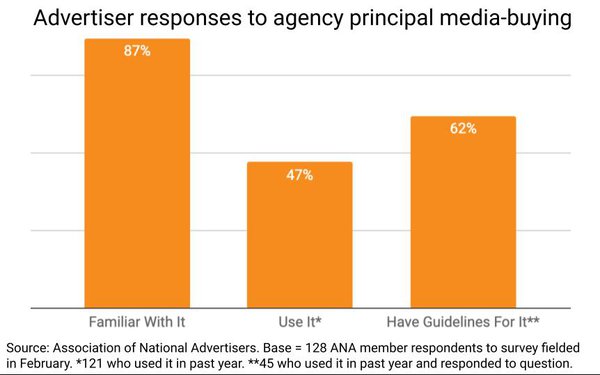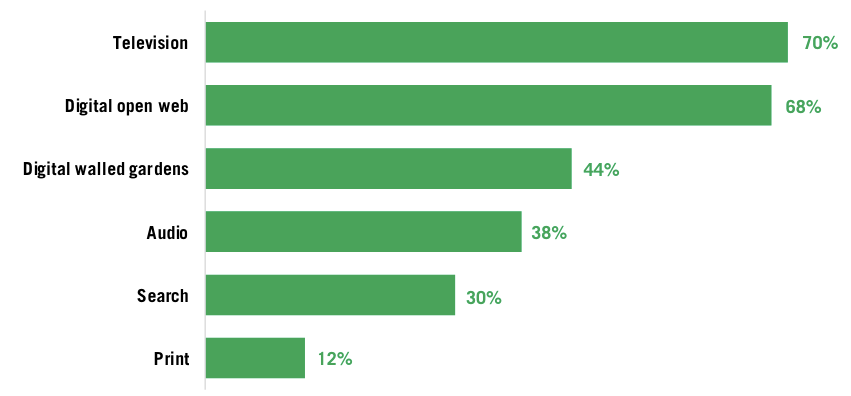Commentary
The Principles Of Principal
- by Joe Mandese @mp_joemandese, May 14, 2024

Nearly a decade after the Association of National Advertisers began focusing on fixing transparency issues associated with agency media-buying, there still are some profound areas of in which major marketers lack knowledge, especially the concept of practice of so-called principal media buying in which the agency, not the client, is the principal owner of the media being used to advertise their products and services.
The concept is highly nuanced, for sure, and often viewed differently depending on who is defining it, but in its simplest form it means the agency is the principal paying to acquire the media, and effectively reselling it to their clients, vs. acting as an agent and buying it on behalf of its client.
The concept can get even more complex, especially when buying digital media in which platforms treat the agencies as principals regardless of what the relationship is between the agency and the client, or in programmatic media-buying, or even with some forms of analog media, especially ones in which agencies pay the media directly with cash upfront or barter goods and services to effectively do the same and create time banks whose credits are used to run a client's campaigns.
advertisement
advertisement
In fact, a survey conducted by the ANA in February found that among advertisers working with agencies that utilize principal media-buying, linear television still is the No. form of media being bought that way (see chart below).
But the reality is many clients probably do not know or truly understand the nature of their agency's principal media-buying practices.
Less than half (48%) of ANA members responding to the survey indicated they were "very familiar" with the concept, while 39% said they were "somewhat familiar" and 13% were not familiar with it at all.
And less than half the respondents (47%) said they used it in the past year, and 62% of them said they have guidelines for how their agency works with them vis a vis principal media-buying.
As the ANA's previous transparency reports uncovered, the reality is many clients who are even familiar with the concept of principal media-buying don't know all the ways their agencies are treated by media sellers in that regard, though there are some areas of agency media-buying where it is explicitly understood and stated.
The report lists examples of explicit principal media-buying practices with in each of the major agency holding companies, including:
- Dentsu's Agyle Advantange and Amnet
- Havas' Havas Inventory
- Interpublic's Orion (a barter media-buying specialist)
- Omnicom's OMnet
- Publicis APEX
- WPP's Nexus (including both Finecast and Xaxis, GroupM Flex, and plista
None of these agency units participated in the ANA's just-released "Principal Media Report," but were listed simply as examples.
As important as the new report is for benchmarking an often opaque area of the media-buying industry, it is incomplete and not representative of the greater world of media-buying, because it is only shows what the biggest U.S. advertisers know and think about the practice. The reality is that in the digital media-buying world, the vast majority of all buys are based on a principal buying the media: long-tail small and medium size advertisers who buy it directly from the platforms themselves.





Joe, regarding the comment on the report, “… it is incomplete and not representative of the greater world of media-buying, because it is only shows what the biggest U.S. advertisers know and think about the practice.” ANA membership is comprised of approximately 900 client-side companies. Yes, that includes many of “the biggest U.S. advertisers.” But it includes many, many small and mid-sized companies as well. As an example, going to the list of ANA Client-Side Marketer member companies under “A” you’ll find big companies including AB InBev, Allstate, and American Express. Yet there are many small and mid-sized companies including Alabama Power Company, American Red Cross, and ASPCA. Further, the respondents to the ANA survey that was featured in the report reflected this diversity. One-quarter of respondents had 2023 annual U.S. media budgets less than $50 million.
Regarding the comment, “The reality is that in the digital media-buying world, the vast majority of all buys are based on a principal buying the media: long-tail small and medium size advertisers who buy it directly from the platforms themselves.” The ANA member survey asked, “Over the past year, roughly what percentage of your company’s total media budget do you estimate to be comprised of principal media or other forms of non-transparent media activity?” The finding – principal media represents a fairly low percentage of a company’s total media budget for most respondents — under 10 percent of the total media budget for 55 percent of respondents. Only 8 percent allocate 50 percent or more of their total media budget to principal media. For most ANA member companies who use an external agency, those agencies are primarily buying as agents. Yet principal-based buying is on the rise … hence the need for our report.
@Bill Duggan: Apologies if my observation was not clear, but by representativeness, I was citing industry estimates that there are more than 12 million brands in the world, most of which are small and medium size businesses. So even if I take the ANA's total membership base -- 900 -- that would equal 0.000075 percent of the total universe, numerically speaking. Not denegrating the importance of ANA members, just pointing out that the vast majority of brands in the world ARE using principal media, because they are the principals buying it directly themselves.
Also appreciate that the ANA defines principal media buying only as agencies serving as the principal with media suppliers.
All good, Joe. Thanks for the conversation and debate!